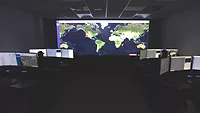Traffic monitoring and security protects Danish toll station

Image courtesy of A/S Storebælt and G4S
The Storebælt Link, a road bridge and rail tunnel in Denmark, straddles the Storebælt strait, a stretch of water which divides Denmark into two.
The Storebælt Link is also the site of a toll station, which services up to 56,000 in transit vehicles per day. Bridge owner and operator A/S Storebælt, a subsidiary of the Danish state-owned Sund & Bælt Holding A/S, needed a traffic monitoring strategy that ensured security at the toll station.
Traffic management team
The toll plaza, which connects Zealand to Funen, has 12 lanes on the westbound side and 10 lanes on the eastbound side. Drivers from Zealand go through the plaza before crossing and those driving from Funen make their payment once across.
In order to secure payment processes, A/S Storebælt implemented a traffic management and security solution operated by G4S, which allows for issues at the toll station to be resolved remotely.
“When a driver has difficulty making a payment or if there is a technical issue, G4S team members, led by our traffic manager, are on hand to talk remotely to the driver using a voice link,” said Brian Zimmerman, the Department Manager at the Storebælt Bridge for G4S. “We can also turn on the video monitoring in any particular lane so we can see the payment machine and help the person remotely, so there is no need to go to the lane in person.
Contactless onsite security
Transport security professionals are based in the traffic control and monitoring room overlooking the toll plaza and the majority of their contact with drivers is remote. In both traffic directions, a single security professional will sit in a booth in one of the lanes, providing additional support. Screens in the control room give the traffic manager an overview of individual lanes and the condition of technical equipment.
Each lane has up to four video cameras configured to photograph a vehicle and its registration number. Using this video monitoring, the traffic manager can help travelers, should an issue arise. Drivers who use the Storebælt Link are able to pay at the plaza in a number of different ways; automatically via an onboard device, by cash, credit or debit card, number plate recognition or by mobile payment.
When a vehicle exceeds a certain size, the traffic manager organizes an accompanying car to transport the vehicle over the bridge and ensures passage through a special transport area. These operations take place several times a day and are always arranged over the phone, even at short notice. Emergency vehicles are also notified to the traffic manager by telephone, which ensures a free lane for the vehicle.
Looking for a reprint of this article?
From high-res PDFs to custom plaques, order your copy today!






